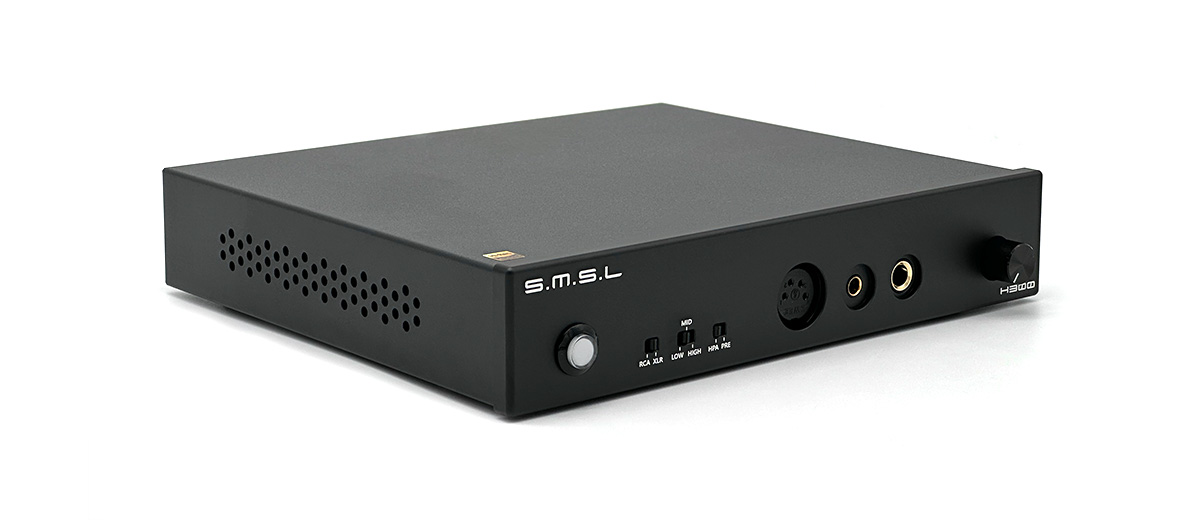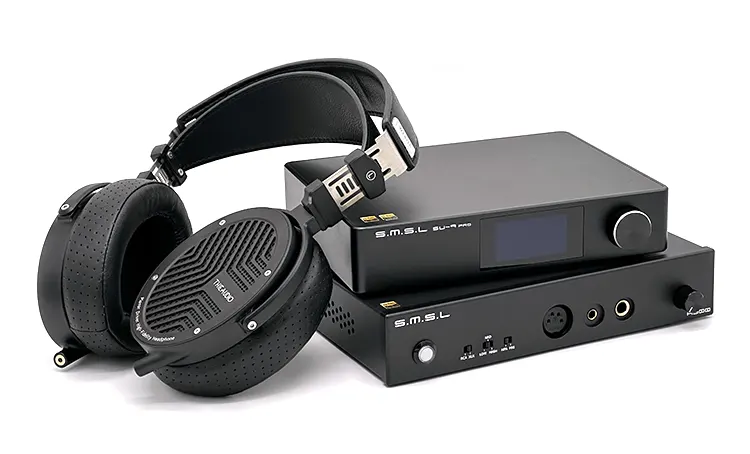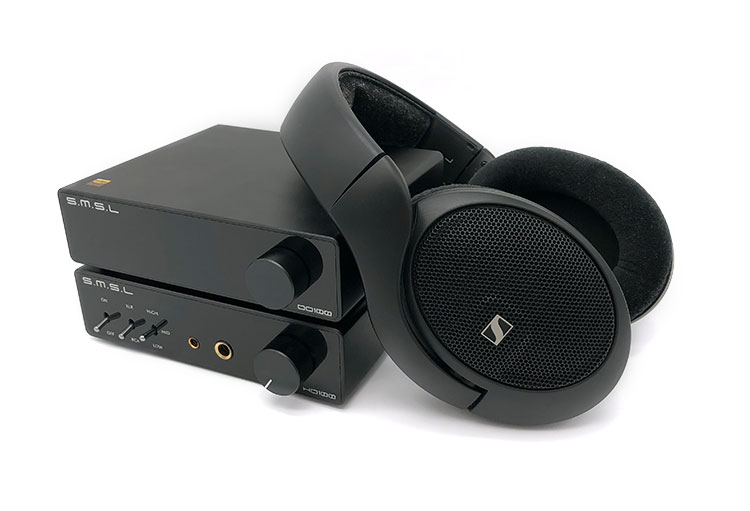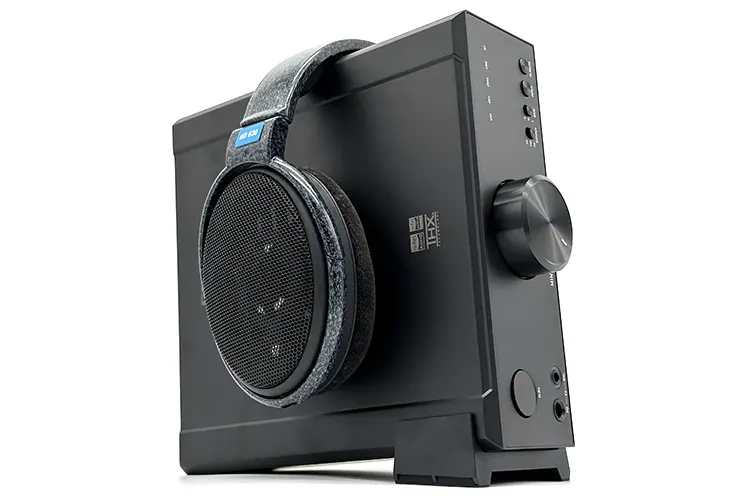Synergy
Power
Within the H300 is a flexible headphone amplifier when it comes to power. While it is indisputably commanding at 10W of maximum power, the 30dB wide three-step gain significantly augments the H300 for any kind of situation.
Since the H300 has a potent get-up-and-go, I’m pleased that with the right gain setting, avoiding the area of channel imbalance didn’t become a problem. For the curious ones, the amp is muted at the 7 o’clock position and will sync up straightaway at 8.
For single-ended use, the ATH-ADX5000 open-back headphones from Audio-Technica seemed too easy for the H300. I set the gain in the middle position, which is 0dB, and I’m already pleased with the wheel near noon.
I had to lower the volume wheel just a smidge for the Sennheiser HD600 plugged using my 4.4mm balanced cable. The Thieaudio Wraith planar headphones are more efficient though so to give it more headroom, I moved the gain down to the low setting.
Pairings
Trying to remove the DAC and headphones from the equation, I did most of the sound impressions with the Burson Conductor 3 Reference and ATH-ADX5000 plugged into the H300.
The only thing I’d like to repeat here is that even with resolving gear I wasn’t able to get a clean and deep bite out of the H300 in the lower frequencies.
Now to match the value of the D300 as best as I could, I brought out the SU-9 Pro. Listening to the ATH-ADX5000, the punch and reverb both loosened and became forgiving. Weight was slipped onto the timbre of instruments like horns and violins which I appreciate to lessen the sterileness of the headphones.
Moving on to the Wraith, its recessed midrange cuts the shout though the easygoing profile could use more give for my taste so it plays more evenly with other instruments. Underneath its wide vocal width, it sweeps away breathier sections and vibrato with less emphasis.
I won’t judge the staging and imaging ability of the H300 using the Wraith since it tends to cluster far objects away. Its planar drivers though are doing an excellent job of etching out the outline of a bass string pluck.
Select Comparisons
SMSL HO100
Technical
If we look at the backside of the HO100, it has the same selection of inputs as what is installed on the H300 though it lacks the other half prepared for pre-amp use.
And while XLR input is available, it doesn’t say it is wired fully balanced internally making an impression that the 3W capable amplifier is less technical than the beefier H300.
While the distortion level of the two amplifiers is the same at 0.00006%, explaining partially the wider body of the H300 is its considerable 64 op-amp count. Both designs are built with a three-level gain though the H300 has a wider gap between the low and high measure.
Design
It may be less in case width and depth, but the glossy effect of the tempered glass on the HO100 somewhat blurs which of the two devices is more upmarket. The fact that there are fewer IOs and controls to take note of on the HO100 is a giveaway though.
The protruding old-school switches on the HO100 may not be as pleasing to look at but I find it easier to access. Its volume knob however is not as remarkable as the one on the H300 noting its more rubbery action.
Performance
The HO100 does have the ability to grab delineation with objects like strings but it tends to relax the edges even more than the H300. Expect better clarity from the H300 because the HO100 struggles more in showing depth causing blurring on warmer songs.
Thinner and more shouty, the upper midrange of the HO100 doesn’t handle vocals as carefully as the H300. While the latter isn’t innocent, it is at least capable of sifting through a scene with better grace.
The HO100 is not as dynamic as the H300. As I observed with a piano solo, the H300 served up an arrangement that is much closer to reality. Aside from the added detail, subtler notes on the H300 are more poised and diffused.
Violins on the H300 are not sized as big which works to its advantage preparing a well-encapsulated serenade in a wider stage. I still like the timbre of the HO100 where it places a balance between fragility and weight.
Topping L30 II
Technical
The L30 II may start with a lower 3.5W power output to compare but it is prouder in other things.
Topping is using their proprietary NFCA module listed with 1.4A of output peak current to satiate planar driver requirements. Without the spec to match in the H300, the L30 II also makes sure dynamic pairs are well fed with its 560mW of thrust for 300W headphones.
The dynamic range of the L30 II is higher at 144dB than the 133dB measured from the H300. In any case, they still have the same 0.00006% THD+N, plus almost equivalent gain levels with only a few dB of difference.
Design
A cute little amplifier from Topping, the L30 II is even less than half the size of the H300. Not needing the extra space for balanced ports, the L30 II has a more negligible footprint that strictly serves single-ended obligations.
Looks-wise, the L30 II captures the attention with its warmer visual. The H300 has a low-key impression tied to a serious set of controls whereas the L30 II puts on a bit of cosmetic with its front glass and red accent.
The switches and volume wheel on the H300 are chosen better in my opinion. The sound of the toggle controls on the L30 II is not as refined and the volume wheel is not as precise.
Performance
Not as spacious on the low end as the H300, the L30 II struggles to ensure its sub-bass does not drop too fast. Nevertheless, the Topping DAC gets its personality in its wider mid-bass that softens thumps. It is more forgiving with subtleties so images formed appear a lot smoother.
The H300 may have a more textured vocal region but the L30 II conveys a more personal take. Sweeter and less bright than the H300, the L30 II is more suited for casual listening and not for those looking to squeeze an airy and wide stage.
It’s easy to tell apart the dynamic ceiling of the L30 II from the H300 as the former hid some parts of a busy rock song I was listening to. The H300 not only staged the scene better, letting the images breathe, but it also added a layer of information to the mix.
FiiO K9
Technical
As a truly balanced combo, the K9 not only divides the amplifier section per channel like what the H300 is doing. Right behind each THX 788+ amplifier of the K9 is a dedicated ES9068AS chip isolating each side from interfering with the other.
Having additional features like Bluetooth and a full-featured app for EQ right out of the box can be more exciting to some.
Choosing the K9 route does remove the complexity of needing to buy a separate box for a DAC but I find it more challenging to upgrade all-in-ones like this since the whole unit has to go when the time comes.
Design
Less wide but deeper and taller, the K9 is a more polished-looking machine. More solidly encased, the body is rock solid and flanked with a wider range of IO and controls noting its job of acting as a DAC as well.
It may not be ideal to some, but due to the crowded rear of the K9, FiiO wasn’t able to include a full-sized XLR in the list of analog inputs that SMSL did for the H300.
On the other hand, the output switch on the K9 has an additional lineout option where the signal is passed through either of the RCA and XLR ports available.
Performance
The H300 is on the more honest side when compared to the bass region of the K9. Both provide access to quality punch and reverb without getting in the way of neighboring instruments. I find the bite of the K9 on more delineated sections to be crisper which plants a safer impression on the H300.
Showing a bit more muscle in each note, the K9 glides softer lacking the same airy quality of the H300 for vocals. The K9 is at least tuned to taper where the H300 exhibits a sharper inclination. While thinner than the K9, the H300 has a smaller image that opens the stage a bit more.
The K9 sets the energy of the electric guitars more evenly with vocals. It allowed some details the H300 missed to pass through which brings more justice to a riff. And making use of the stage width available, the K9 layered the clapping audience with a bit more finesse which adds resolve.
Our Verdict
Discrete desktop amplifiers get assigned to me less frequently than other types of audio products and I was not disappointed that this new one from SMSL got added to the list.
I went into this review with a trifling opinion about SMSL amps, however, the H300 expressed itself with ample allure and technical traits substantiating it is not all just talk.
However, I wouldn’t press the H300 to furnish humming notes with a snappish outline. In filling a restrained bite, subtleties can get overlooked. I do find consolation in the punch and timbre of the low-end.
If the D300 indicates anything, it’s that your wallet should be ready to burn a little bit more dough to keep up with the potential of the H300. Only be mindful of your choice since the H300 tends to become edgy, especially in the upper frequencies.
However, with a 10W power reserve and a built-in three-level gain to couple with a wide range of gears, it makes sense to think of the H300 as a long-term desktop upgrade. Its wide selection of IO also covers most of the common cables and interconnects used in the industry so no one will feel left out.
SMSL H300 Technical Specifications
- Inputs: Balanced, Unbalanced
- Headphone Outputs: 4.4mm Balanced, XLR 4-pin, 6.35mm Unbalanced
- Pre-outputs: Balanced, Unbalanced
- Output power: 10Wx2 (16W), 5Wx2 (32W)
- Dynamic Range: 133dB
- THD+N: -123dB, 0.00006% (1kHz, 32W)
- Frequency Response: 20Hz-100kHz (-0.5dB)
- Gain (Unbalanced): Low (-11.5dB), Middle (0dB), High (18.5dB)
- Gain (Balanced): Low (-6dB), Middle (6dB), High (24.5dB)
- Power Consumption: <50W
- Size: 210x40x178mm (WxHxD)
- Weight: 1.23kg






